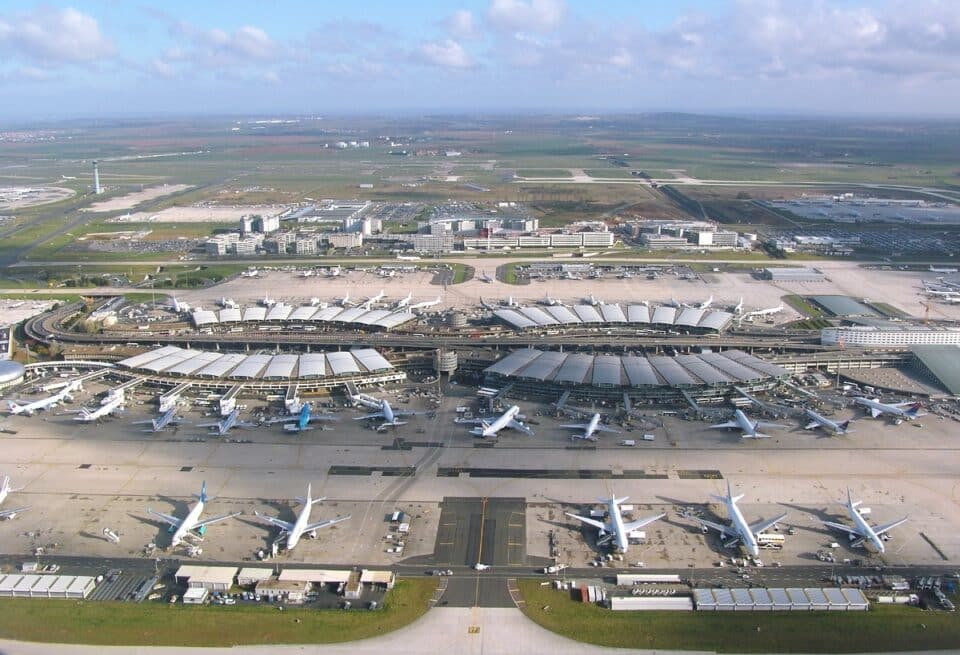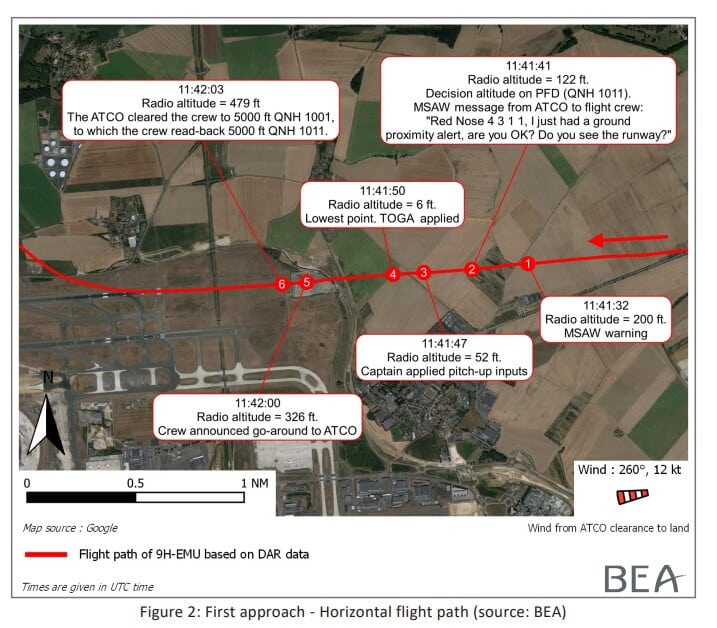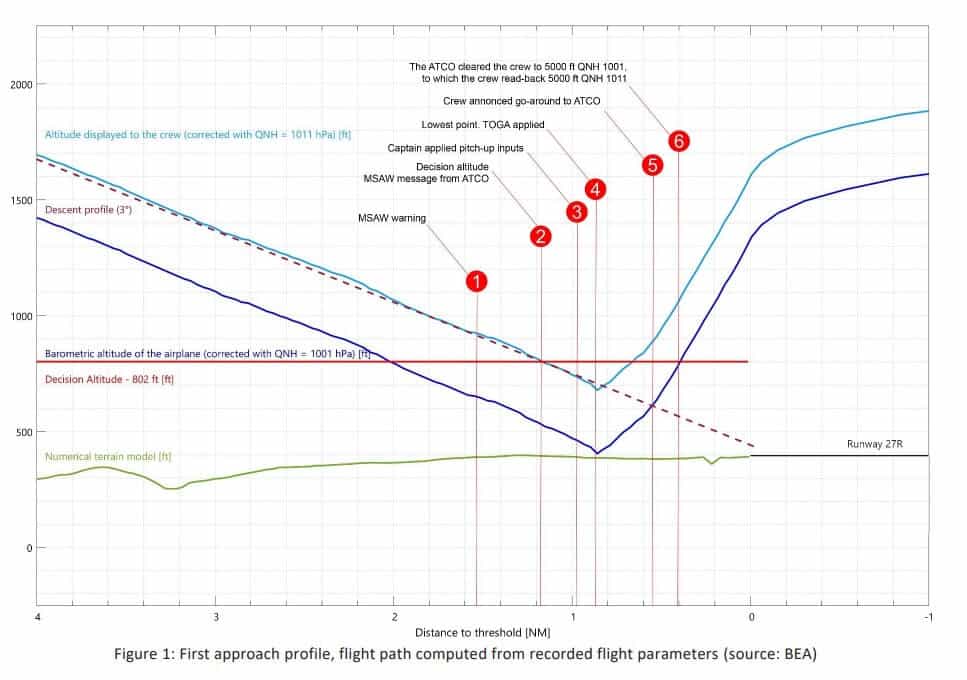Aviation
Airbus A320 comes within 6 ft of crashing while on approach to Paris

According to a report by French authorities, an aeroplane carrying 172 passengers came within 6 feet (1.8 metres) of crashing while making its approach to Paris Charles de Gaulle (CDG). On May 23, 2022, at at 11:40 UTC, the Airbus A320, with the registration 9H-EMU and operated by wet lease expert Air hub, was coming in to land at CDG on a trip from Stockholm Arlanda when the near-collision occurred because of an improper altimeter setting.
The approach was flown 280 feet lower than it should have been because the controller repeatedly gave the crew the wrong QNH setting, 1011 instead of 1001, and the crew failed to notice the error. The Minimum Safe Altitude Warning (MSAW) was triggered on both approaches during this serious incident, and the controllers failed to use the prescribed MSAW phraseology. The report noted that the crew was not provided the QNH or any instructions to verify their altitude.
For Air hub, the BEA recommends that crews are made aware of the importance of the correct QNH setting for such RNP approaches and implement a procedure to cross-check QNH information with another source.
First approach – Horizontal flight path
The flight, which was being flown on behalf of Norwegian Air Shuttle, was making an LNAV/VNAV minimum RNP approach to runway 27 at CDG. Because the aircraft will get its altitude information from the barometric altitude systems, this style of approach depends on pilots using the proper QNH setting.
According to the preliminary report from the BEA, air traffic controllers received a ground Minimum Safe Altitude Warning at 11:41:32, when the aircraft was at an indicated altitude of 617 ft on the correct QNH of 1001, or 200 feet above the ground according to the radio altimeter, at 1.53 nautical miles from the runway threshold. With a QNH setting of 1011, the crew would have seen an indicated altitude of 891 ft. CDG is 392 ft above sea level.
At 1.2 nautical miles from the runway, nine seconds later, the crew passed the decision altitude of 802 feet in accordance with the inaccurate 1011 QNH setting. The crew decided to turn around since they could not see the runway. However, the aircraft was 122 feet above the ground when the QNH was adjusted to the proper altitude of 1001, which was 537 feet.
The autopilot was removed and the captain pitched the aircraft up at 11:41:47, 15 seconds after ATC received the alert and during the controller’s call to the aircraft. The aircraft’s lowest point above the earth, measured by the radio altimeter at just 6 ft, was reached three seconds later and when it was still 0.8 miles from the runway.
Second approach
On the second approach for landing, the faulty QNH setting was not corrected, and the aircraft was again 280 ft lower than it should have been. Another MSAW was generated when the aircraft was 3.1 nm from the runway at an indicated altitude of 1,403 ft on QNH 1011 (but 1,131 ft QNH 1001, 842 ft per the radio altimeter).
When called by the controller, the crew said they did not understand why the message had been received but that they were visual with the runway. However, runway PAPI lights indicated to the crew that they were lower than they should be, so they corrected the approach and landed safely.
Courtesy : BEA

Aviation
COMAC Unveils Plans for the C929 to Rival Airbus and Boeing

After the success of China’s first C919 aircraft, the country is setting its sights on developing a larger plane. COMAC (Commercial Aircraft Corporation of China) has officially confirmed plans to build a widebody aircraft, marking a significant step in its aircraft lineup.
Traditionally, Airbus and Boeing dominate the widebody aircraft market, with decades of expertise in developing planes and engines capable of carrying heavy payloads. China, which currently relies on imported engines, is now aiming to challenge these giants with its own widebody jet, the C929, designed to compete with the Airbus A350 and Boeing 777.
American Airlines Is Looking for Flight Attendants: Apply Now
The C929 will be China’s first independently developed long-range widebody aircraft. It adheres to international airworthiness standards and boasts independent intellectual property rights. The baseline version is designed to seat 280 passengers and offers a range of 12,000 kilometers, catering to global demand for both regional and international air travel.
Russia, which also needs reliable narrowbody and widebody aircraft, could become a key customer for the C929. Additionally, China plans to target the broader Asian market as it continues to expand its aviation capabilities.
Close Call at Heathrow: BA Flight Narrowly Escapes Drone Collision
China’s aviation progress includes the ARJ21 (now called C909), a regional jet with 100 seats for shorter routes, and the C919, a narrowbody jet with 180 seats designed to rival the Boeing 737 MAX and Airbus A320. Both models have found increasing demand in the domestic market.
At China’s largest air show in Zhuhai, COMAC announced that Air China will be the launch customer for the C929 widebody jet, though details about order size and delivery timelines were not disclosed.
Other major deals announced by COMAC include:
- Hainan Airlines: Firm orders for 60 C919 and 40 C909 regional jets.
- Colorful Guizhou Airlines: 30 C909 jets, with 20 firm orders and 10 provisional agreements.
The C929, renamed from the CR929 after Russia withdrew from the joint development project in 2023, is expected to carry 280–400 passengers with a range of 12,000 kilometers, competing directly with Boeing’s 787 Dreamliner.
According to COMAC’s deputy general manager, Tong Yu, the first fuselage section of the C929 is expected by September 2027, with prototype test flights anticipated soon after.
-

 Aviation2 months ago
Aviation2 months agoMicrosoft Flight Simulator Raises $3 Million to Bring Back the An-225 Mriya
-

 Airlines2 months ago
Airlines2 months agoQantas Engineers Stage Walkout Over Cost of Living Concerns
-

 Airlines2 months ago
Airlines2 months agoQatar Citizens Can Travel to the United States Without a Visa
-

 Aviation2 months ago
Aviation2 months agoQatar Airways bans these new Electronic Devices on plane
-

 Airlines2 months ago
Airlines2 months agoJapan Airlines Rolls Out Free Domestic Flights to International Passengers
-

 Defence2 months ago
Defence2 months agoWhich Country Has the Largest Fleet of Fighter Aircraft?
-

 Airport2 months ago
Airport2 months agoWestern Sydney Airport Welcomes Its First Plane After 6 Years of construction
-

 Aviation2 months ago
Aviation2 months agoDid you know ? Once Boeing 747 carried 1088 passenger in 1991










